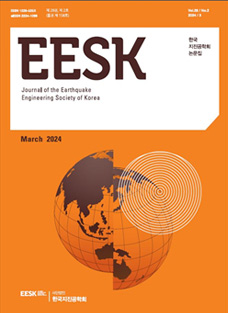![]() Journal Search Engine
Journal Search Engine
ISSN : 1226-525X(Print)
ISSN : 2234-1099(Online)
ISSN : 2234-1099(Online)
Journal of the Earthquake Engineering Society of Korea Vol.18 No.4 pp.161-170
DOI : https://doi.org/10.5000/EESK.2014.18.4.161
DOI : https://doi.org/10.5000/EESK.2014.18.4.161
Newmark 기반 변형해석에 의한 필댐의 내진저항성 연구
A Study on the Seismic Resistance of Fill-dams by Newmark-type Deformation Analysis
(Received 2 July 2013; Revised 2 April 2014; Accepted 29 April 2014)
Abstract
Newmark-type deformation analysis has rarely been done in Korea due to the popularity of simple pseudo-static limit equilibrium analysisand detailed time-history FE/FD dynamic analysis. However, the Korean seismic dam design code updated in 2011 prescribesNewmark-type deformation analysis as a major dynamic analysis method for the seismic evaluation of fill dams. In addition, a design PGAfor dynamic analysis is significantly increased in the code. This paper aims to study the seismic evaluation of four existing large fill damsthrough advanced FEM/Newmark-type deformation analyses for the artificial earthquake time histories with the design PGA of 0.22g.Dynamic soil properties obtained from in-situ geo-physical surveys are applied as input parameters. For the FEM/Newmark analyses,sensitivity analyses are performed to study the effects of input PGA and Gmax of shell zone on the Newmark deformation. As a result, interms of deformation, four fill dams are proved to be reasonably safe under the PGA of 0.22g with yield coefficients of 0.136 to 0.187, whichare highly resistant for extreme events. Sensitivity analysis as a function of PGA shows that PGA30cm (a limiting PGA to cause the 30 cmof Newmark permanent displacement on the critical slip surface) is a good indicator for seismic safety check. CFRD shows a higherseismic resistance than ECRD. Another sensitivity analysis shows that Gmax per depth does not significantly affect the site responsecharacteristics, however lower Gmax profile causes larger Newmark deformation. Through this study, it is proved that the amplification ofground motion within the sliding mass and the location of critical slip surface are the dominant factors governing permanent displacements.
Reference

Frequency Bimonthly
Doi Prefix 10.5000/EESK
Year of Launching 1997
Publisher Earthquake Engineering Society of Korea



Online Submission
submission.eesk-j.or.kr
EESK
Earthquake Engineering Society of Korea







